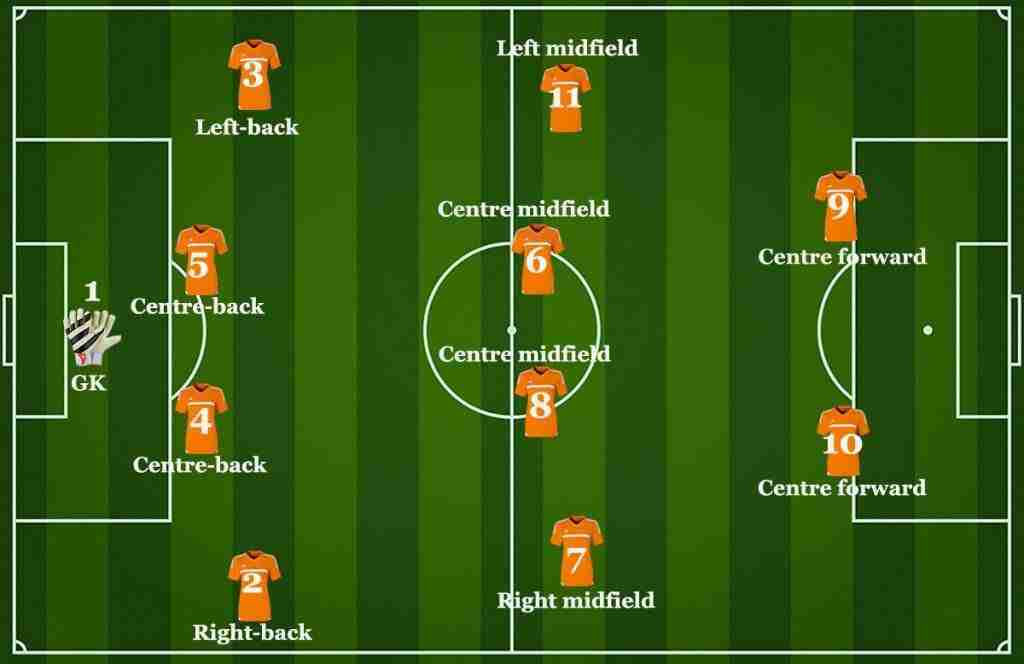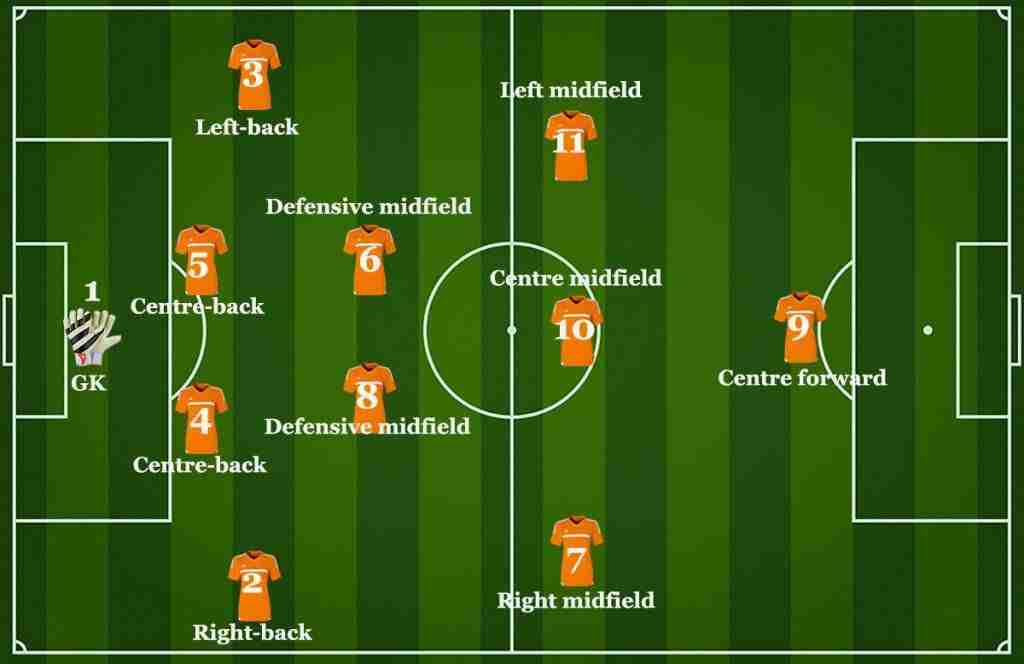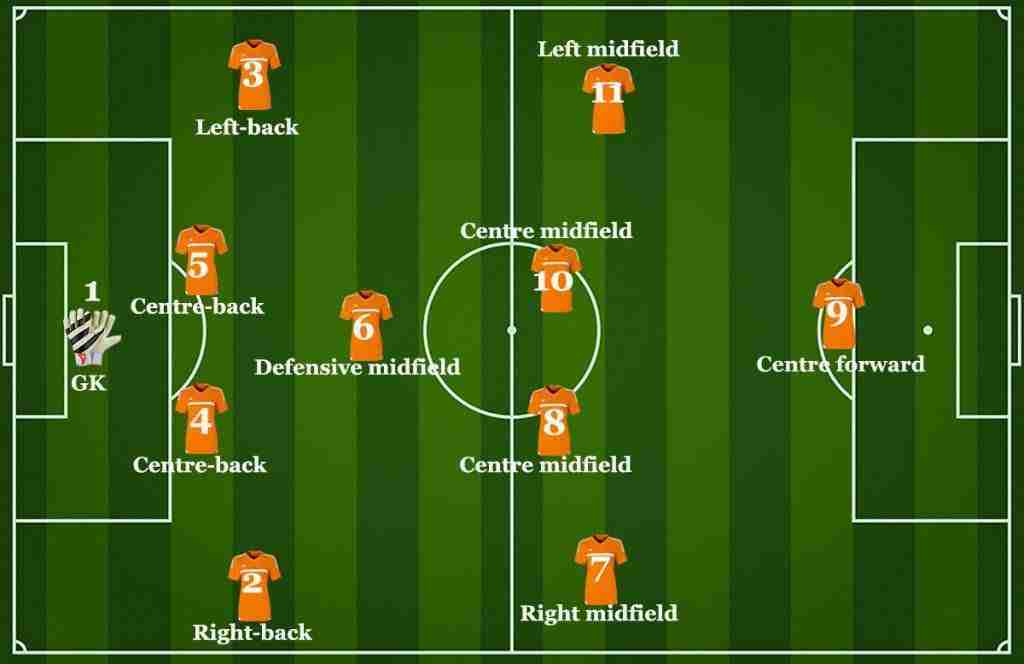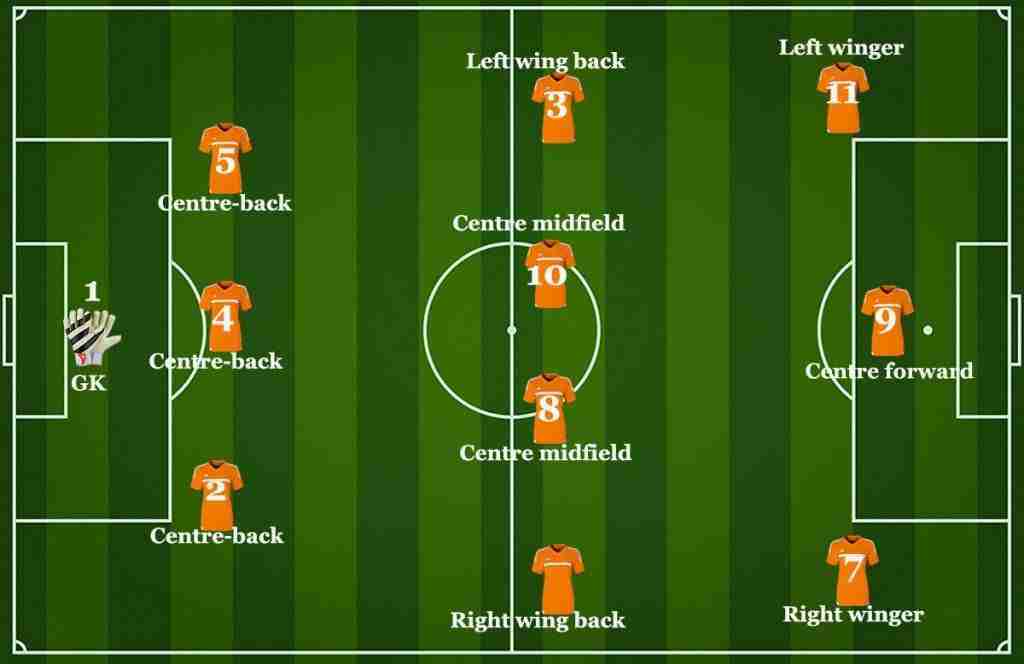Soccer formations are the unsung architects of every thrilling match, quietly dictating the tempo, tactics, and narrative behind the scenes. Think of them as the blueprint, setting the stage for awe-inspiring goals, impenetrable defenses, and edge-of-your-seat action. It’s not just about the players or the coach; the formation they choose can make or break the game.
That is why it is absolute important to understand the best soccer fornations to get a complete grasp of how the game is played.
In this captivating rundown, we’ll delve into the top 7 formations dominating professional soccer today. We will be exploring the 4-4-2, 4-3-3, 4-5-1, 3-5-2, 4-2-3-1, 3-4-4 and the 5-3-2 soccer formations. We’re not just listing them; we’ll deep-dive into each formation’s unique tactics and strategies, punctuated by real-world examples from renowned teams.
So buckle up, soccer enthusiasts because your understanding of the game is about to level up!
4-4-2 soccer formations

Step into the tactical time machine and say hello to the classic 4-4-2 formation. A soccer staple that has both historical roots and modern relevance. Credit for its invention goes to Viktor Maslov, the mastermind who also introduced the concept of pressing.
Let’s dissect its two powerhouse variants: the flat 4-4-2 and its flashier cousin, the 4-4-2 diamond. The flat version features a textbook backline of two center-backs flanked by full-backs, while the midfield quartet lines up side-by-side in the center of the pitch. Sounds straightforward? It is, but don’t underestimate its effectiveness.
Then there’s the diamond, a glittering formation that places a defensive midfielder as the anchor, two wing midfielders stretching the play, and an attacking midfielder providing creative support to the two up-front strikers. Remember Arsène Wenger’s iconic ‘Invincibles’? They made magic with Robert Pires and Freddie Ljungberg on the wings, backed up by the lethal duo of Thierry Henry and Dennis Bergkamp.
One of this formation’s striking benefits is its offensive firepower. The dual strikers open doors for midfielders to surge forward and join the attack. But wait, full-backs like Patrice Evra and Gary Neville under Sir Alex Ferguson’s tutelage show it’s not just about the forwards and midfielders. Your full-backs must also be dynamic, contributing both defensively and offensively.
Speaking of dynamism, let’s talk about the real MVPs: the midfielders. Think Patrick Vieira in Arsenal’s golden years or modern marvels like N’Golo Kanté and Paul Pogba. These players are the engine rooms, tirelessly oscillating between defense and attack.
While the traditional 4-4-2 might not be the go-to formation in today’s soccer zeitgeist, eclipsed by formations like 4-3-3, it’s far from obsolete. In the hands of a tactical genius, this formation can still sing. It may have lost some limelight, but with the right maestro conducting the symphony, the 4-4-2 can rise to prominence once again.
4-3-3 soccer formations

Next up, the 4-3-3 formation, arguably the epitome of modern soccer success. This strategic marvel didn’t win universal acclaim overnight, but once it did, it felt like soccer had found its soulmate. Picture it: Barcelona at its zenith under Pep Guardiola, the maestro who crafted the masterpiece that we now associate with some of the most dazzling football ever played.
In the midfield, imagine the mesmerizing trio of Busquets, Xavi, and Iniesta, controlling the tempo like maestros conducting an orchestra. Flash forward to the attack, where David Villa and Pedro flanked none other than the footballing sorcerer, Lionel Messi. Need proof of its potency? How about that unforgettable 5-0 thrashing of José Mourinho’s Real Madrid.
One of the key advantages of 4-3-3 is its lethal counter-attacking prowess. Picture some of the best players in the world in Messi, Suárez, and Neymar, widely hailed as one of the deadliest attacking trios in soccer history—from 2014 to 2017. Not to be forgotten are the indomitable Dani Alves and Abidal, whose overlapping runs added another layer of threat from the flanks.
But no formation is without its Achilles’ heel. For the 4-3-3, it’s the vulnerability to being overrun in the midfield, especially if opponents stack it with four or even five players. The midfield trio must be quick thinkers and even quicker with their passes to avoid surrendering possession.
Yet, when executed to perfection, the 4-3-3 is nothing short of soccer alchemy. Just ask Jürgen Klopp, whose Liverpool side rode this formation to Champions League and Premier League glory in successive seasons. So, if you’re all about attacking flair balanced with midfield control, look no further: the 4-3-3 might just be your holy grail
4-2-3-1 soccer formations

Step aside, traditionalists—the 4-2-3-1 formation is the modern-day maverick that’s taken the soccer world by storm. Think of it as the Swiss Army knife of formations: versatile, balanced, and equipped to deal with almost any tactical conundrum. This formation is the tactical darling that has redefined the way we think about soccer strategy today.
Picture the scene: two holding midfielders anchoring the fort, providing that essential shield in front of the defense. They are your on-field generals, tacticians in boots—think N’Golo Kanté or Joshua Kimmich. Just ahead, an attacking trio with enough flair and creativity to make even the sternest defenses seem like amateur hour. Imagine the likes of Kevin De Bruyne pulling the strings from the central attacking midfield role, flanked by rapid wingers like Raheem Sterling and Mohamed Salah.
But let’s not forget the lone striker up top—the focal point of all that attacking ingenuity. Whether it’s a lethal poacher like Robert Lewandowski or a dynamic forward like Karim Benzema, this lone wolf feeds off the creative juices flowing from the midfield, turning half-chances into headline moments.
Ole Gunnar Solskjaer’s Manchester United is a prime example of the 4-2-3-1 in action. Bruno Fernandes reigns supreme in the number ten role, orchestrating play and occasionally stepping up as a second striker. Meanwhile, defensive midfielders like Fred and Scott McTominay offer a safety net, allowing creative forces on the wings to surge forward with less defensive worry.
However, let’s be clear: the 4-2-3-1 is not for the faint of heart. It demands a lot from its players. Those holding midfielders? They need the lungs of marathon runners and the tenacity of prizefighters. The attacking trio must be in sync, almost telepathic. And the lone striker has to be as comfortable holding up play as they are smashing volleys into the back of the net.
While no formation is without its kinks, the 4-2-3-1 can sometimes struggle against packed midfields or ultra-defensive setups when it clicks, it’s poetry in motion. So, if you’re after a formation that offers defensive solidity, midfield control, and attacking brilliance, the 4-2-3-1 might just be your ticket to soccer nirvana.
4-5-1 soccer formations

Next up on our tactical journey is the 4-5-1 formation. A soccer strategist’s dream. Why does it earn such high praise? This setup masterfully strikes a balance between defensive solidity and attacking flair, making it an ideal choice in today’s ever-evolving soccer landscape.
Need evidence? Look no further than Ole Gunnar Solskjaer’s Manchester United. More specifically, they often deploy a 4-2-3-1 variation. Imagine a steadfast defensive line shielded by a pair of central midfielders, one a defensive stalwart, perhaps Scott McTominay or Fred, and the other a box-to-box magician like Paul Pogba.
As we venture upfield, speed is the name of the game. No wonder Marcus Rashford, arguably the club’s finest winger, is an automatic selection. Opposite him, you’ll find a rotation of speedsters like Daniel James or Mason Greenwood. At the heart of it all is the brilliant Bruno Fernandes, a playmaking wizard who sometimes morphs into a second striker. Up top? The formidable lone striker—Anthony Martial.
This tactical setup has turned Manchester United into a counter-attacking powerhouse. Remember when Man United snapped Manchester City’s 21 game winning streak in the 2020/2021 Premier league season? That’s the 4-5-1 magic at work. But it’s not all roses.
The 4-5-1 demands patience and adjustment time. Your midfielders must be relentless engines, constantly shifting between attack and defense. A less-centralized alternative is the 4-1-4-1, featuring a lone defensive midfielder almost integrated into the backline, freeing up four more attack-minded midfielders.
Also, an attacking midfielder can also be used as a “false nine” to help the load traditional stricker during attacking possessions.
There’s a vulnerability, too. With only one key player linking defense and attack, the formation can falter against low blocks. Nonetheless, when executed well, the 4-5-1 can be a balanced, adaptable, and deadly weapon in any soccer arsenal.
3-5-2 soccer formations

Dive into the tactical intrigue of the 3-5-2 formation, where defense isn’t just an obligation—it’s an art form. This formation isn’t for the faint-hearted; it demands a rock-solid back three with top-notch coordination. Whether you opt for a trio of center-backs or a mix with full-backs, these players are your last line of defense—literally.
Spacing is key here. Picture a tightly-knit unit with no more than 15 yards separating each defender. This was brilliantly showcased during England’s 2018 World Cup semi-final against Croatia. Remember that defensive wall of Harry Maguire, John Stones, and Kyle Walker? It was all underpinned by the midfield anchor—Jordan Henderson.
Now, let’s talk midfield—an area bursting with strategic possibilities. You could opt for a single defensive shield like Henderson, or deploy a double pivot to morph into a more nuanced 3-2-3-2 formation. But here’s the catch: your midfielders need to be exceptionally skilled. They must excel at tracking back, moving in harmony, and winning those crunching 50/50 battles.
The intricacies don’t end there. The flanking defenders have the freedom to stretch wide, aiding in ball distribution and alleviating tight spaces. But caution! Whether they’re natural center-backs or not, their defensive instincts must be razor-sharp, and crossing the halfway line should be a rare venture.
Need real-world examples? Look no further than Antonio Conte’s tactical mastery with Chelsea and Juventus, or Louis van Gaal’s tenure at Manchester United. When executed to perfection, the 3-5-2 is more than a formation—it’s a tactical symphony that can orchestrate victory.
3-4-3 soccer formations

In the midfield, the formation showcases four players who act as the engine room. Two central figures and two wing-backs who can dominate the flanks. These wing-backs are the Swiss Army knives of soccer, defending like lions and attacking like gazelles. They whip in crosses, make late runs into the box, and tirelessly track back on defense.
Up front, the trio of forwards is where the real magic happens. With a central striker flanked by two wingers, they present a triple threat that keeps opposition defenders guessing. Remember Chelsea’s title-winning campaign under Conte? Precisely.
However, let’s be real, this formation is not without its risks. If your wing-backs are caught too far up the field or if the midfield is overrun, then prepare for a potential defensive crisis. But hey, who said high reward comes without high risk?
In summary, if you love a dynamic, attack-minded game, the 3-4-3 could be your tactical dream come true. Just make sure your team has the stamina and skill to pull it off.
5-3-2 soccer formations
Wrapping up our formation frenzy, let’s turn our spotlight onto the ultimate bastion of defense: the 5-3-2 formation. Often the go-to strategy for underdog teams facing soccer juggernauts, this formation is all about a defensive stronghold, perfect for counter-attacking brilliance.
So, why is the 5-3-2 considered a lifesaver for weaker squads? Picture this: a fortress-like backline made up of three central defenders flanked by full-backs. The midfield offers tactical flexibility; sometimes, the second striker drops into the middle, effectively morphing the formation into a 5-4-1 for extra defensive cover.
But what about offense? While the midfield is compact and primarily defensive, you still have options. The wing-backs can bolt down the flanks, either delivering crosses or eating up valuable time. In this formation, the two strikers must be clinical, capitalizing on the rare chances that come their way. They’re also expected to drop back and aid in midfield ball recovery.
Need proof that this formation can work wonders? Cast your minds back to the 2014 World Cup. The Dutch team, managed by Louis van Gaal, stifled Spain’s star-studded midfield, leading to a jaw-dropping 5-1 victory. It was a tactical masterclass, offering zero room for playmakers like David Silva, Xavi, and Iniesta.
The 5-3-2 isn’t just about parking the bus; it’s a tactical tool that demands every player punch above their weight. Whether you’re snuffing out attacks or seizing those rare offensive opportunities, precision is key. This formation may offer fewer chances, but when they come, you’ve got to make them count. Because in soccer, sometimes defense is the best form of attack.
Conclusion
In wrapping up, each of the stellar soccer formations we’ve explored has its unique imprint on the game’s tempo and outcome. Our top pick? The versatile 4-5-1 formation takes the crown for its unparalleled ability to strike a seamless balance between stalwart defense and dynamic offense.
For those who prefer to dial up the aggression, the 4-3-3 formation serves as a formidable runner-up, letting you unleash a full-throttle attacking prowess. But remember, the magic isn’t just in the formation. It’s in your team’s chemistry and execution. So choose wisely, because the right formation can be your secret weapon to soccer stardom!
Ready to up your game even further? Don’t miss our comprehensive guide on essential, Soccer Player Equipment, where we delve into the gear that can elevate your performance on the field!


